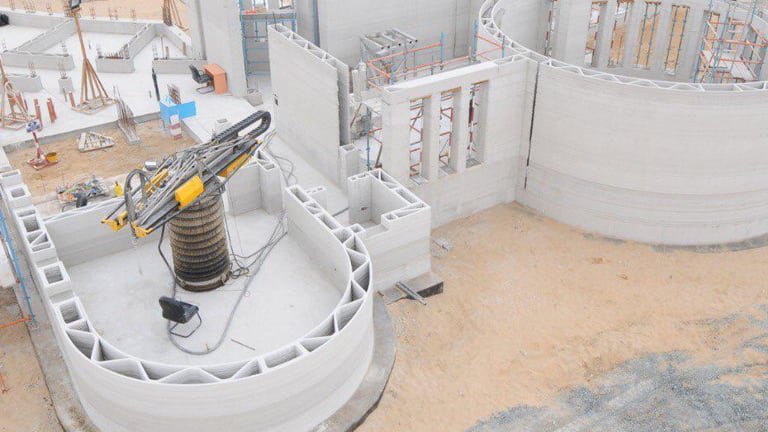Office market at pivotal 'normalization' point as macroeconomic factors weigh on economy.
NAIOP’s latest research reports address how real properties, particularly office, industrial and mixed-use properties, impact and benefit communities throughout North America. These reports disseminate research findings for individuals and organizations engaged in real estate development, investment and operations to plan and develop better communities.

Office market at pivotal 'normalization' point as macroeconomic factors weigh on economy.

The rapid rise of generative AI is reigniting interest in its applications across commercial real estate. Beyond well-documented use cases in financial analysis, market research and customer service, AI is driving significant productivity gains in logistics and industrial real estate.

The NAIOP CRE Sentiment Index for September 2025 is 56, an increase from the March 2025 score, indicating that respondents expect conditions for commercial real estate to improve over the next 12 months.

Given this continued uncertainty and persistently high interest rates, the current NAIOP Industrial Space Demand Forecast projects that net absorption will be nearly flat over the second half of 2025 (2.8 million square feet).

The NAIOP Research Foundation commissioned this report to examine the economic benefits of commercial construction across four distinct CRE asset classes, namely industrial, retail and hospitality, office, and institutional multifamily housing during 2024. The report also describes the benefits of commercial brokerage, property management and landlord operations.

The NAIOP Market Monitor provides insights into shifting market conditions and capital flows across the United States. The report’s findings can help investors and developers identify regional trends and identify markets that align with their risk and return objectives or warrant further examination. The 2025 NAIOP Market Monitor identifies a resurgence of sales activity in office markets that likely reflects investors acting on the stabilization in overall demand for office space.

The national market for office space continued to rebound with a fourth consecutive quarter of positive net absorption.

The NAIOP Research Foundation commissioned this study to explore the challenges and opportunities associated with succession planning for CRE firms. The study draws on Wipfli’s experience advising firms on succession planning and interviews with CRE professionals at various stages of the succession planning process who represent a broad cross-section of CRE firms.

In the second half of 2024, U.S. industrial net absorption totaled 96.9 million square feet, bringing the annual total to just 170.8 million square feet. This is the lowest annual rate since 2011, as long-term interest rates remained elevated despite the Federal Reserve’s initial cuts to the federal funds rate.

Development and construction of new commercial real estate in the United States – office, industrial, warehouse and retail – generates significant economic growth at the state and national levels. This annual study, published by the NAIOP Research Foundation, measures the contribution to GDP, salaries and wages generated and jobs supported from the development and operations of commercial real estate.

Net office space absorption in the fourth quarter of 2024 is expected to be 9.4 million square feet, with another 10.8 million square feet of positive absorption for the full year in 2025 and 3.9 million square feet of positive absorption in the first three quarters of 2026.

The NAIOP Research Foundation commissioned this report to provide insight into best practices in reverse logistics supply chain design and the implications for facility location and design. The study is of use to organizations seeking to improve their reverse logistics capabilities and to supply chain executives and developers interested in calibrating building design and location to maximize operational revenue and reduce costs.

Total net absorption for the second half of 2024 is forecast to be approximately 114 million square feet, full-year absorption in 2025 is forecast to be around 249 million square feet, and absorption in the first half of 2026 is forecast to be approximately 154 million square feet.

The NAIOP Market Monitor provides insights into shifting market conditions and capital flows across the United States. The report’s findings can help investors and developers identify regional trends and markets that align with their risk and return objectives or warrant further examination. The 2024 NAIOP Market Monitor indicates a continuation of several post-pandemic trends in office and industrial real estate markets.

The NAIOP Research Foundation commissioned this report to examine best practices in recruitment, training and retention for commercial real estate development firms. The study draws on interviews and focus groups with developers, interviews with executive recruiters, and a survey of NAIOP members.

The office market performed worse in the first quarter of 2024 than previously forecast, with national office net absorption totaling a negative 13.4 million square feet.

For the 2024 edition of Commercial Real Estate Terms and Definitions, the author reviewed secondary sources and sought input from members of the national research directors group as well as other CRE practitioners to identify terms that needed to be added or amended to match current use.

With the U.S. economy expected to continue to grow slowly, the authors estimate that quarterly net absorption of industrial space will average 14.0 million square feet per quarter over the next two years, or 62.8 and 49.1 million square feet in 2024 and 2025, respectively.

Development and construction of new commercial real estate in the United States – office, industrial, warehouse and retail – generates significant economic growth at the state and national levels. This annual study, published by the NAIOP Research Foundation, measures the contribution to GDP, salaries and wages generated and jobs supported from the development and operations of commercial real estate.

The NAIOP Research Foundation commissioned this report to examine the trends behind reshoring and nearshoring and to evaluate how related investments in manufacturing are affecting North American markets for industrial real estate and its two largest components: warehousing/logistics space and manufacturing space.


The NAIOP Research Foundation commissioned this report to identify best practices for promoting DEI within CRE firms. The study draws from existing studies on DEI, as well as interviews with a representative sample of practitioners at CRE firms that have pursued DEI initiatives.

Given current economic conditions and recent demand trends, the authors estimate that quarterly net absorption of industrial space will average 52.6 million square feet over the next two years. Read the full report from the NAIOP Research Foundation.

The NAIOP Research Foundation commissioned this report to examine the current state of hybrid work and how it affects the office sector. The study draws from survey and market data provided by CBRE to explore how occupiers are approaching their use of office space, and the building locations, features and amenities they prioritize.

In this first NAIOP Market Monitor report, the authors compare the positions of large and mid-sized U.S. industrial and office markets in grids at the close of the first quarter of 2023 with the pre-pandemic positions of the same markets at the end of the first quarter of 2019, and highlight some insights usually not seen using a tier or ranking approach.

The NAIOP Research Foundation commissioned this report to offer design recommendations that improve occupant well-being. The authors conducted secondary research, observed conditions in existing distribution centers and interviewed occupants to collect information on key wellness concerns. They then drew from these findings to design a prototype distribution center with elements and features that contribute to a healthier and safer work environment.

The brief examines development approvals processes across 100 jurisdictions from 30 U.S. states and the Canadian province of Ontario, and builds on The Development Approvals Index: A New Tool to Evaluate Local Approvals Processes (the Index) released by the NAIOP Research Foundation in February 2021.

The national office market experienced total negative net absorption of 21.3 million square feet through the fourth quarter of 2022 and the first quarter of 2023, bringing the vacancy rate to 17.8 percent, the highest level since the second quarter of 1993.

Despite rising interest rates and growth in the supply of new space entering the market, the outlook for industrial real estate remains bright as supply chain conditions steadily improve. Low vacancy rates will continue to support growth in rents and property values. Read the full report from the NAIOP Research Foundation.

Development and construction of new commercial real estate in the United States – office, industrial, warehouse and retail – generates significant economic growth at the state and national levels. This annual study, published by the NAIOP Research Foundation, measures the contribution to GDP, salaries and wages generated and jobs supported from the development and operations of commercial real estate.

Net office space absorption in the fourth quarter of 2022 is forecast to be 7.1 million square feet, with absorption in 2023 forecast to slow to 8.1 million square feet for the entire year. Moving forward, the forecast projects that absorption in the first three quarters of 2024 will total 13.3 million square feet.

To gain a sense of how CRE firms are using advanced data analytics, the NAIOP Research Foundation commissioned this report to examine applications in site selection, design and valuation for commercial buildings. The author conducted secondary research and interviewed brokers, data providers, investors, developers and professionals at CRE technology firms.

Former industrial sites and other properties that may be contaminated – commonly called brownfields – can be viable targets for redevelopment, however the costs and risks associated with environmental remediation often make these projects challenging. The NAIOP Research Foundation commissioned this brief to offer insights into the key considerations that guide sustainable brownfield redevelopment.

The NAIOP Research Foundation commissioned this report to examine the economic benefits of commercial construction across four distinct CRE asset classes, namely industrial, retail and entertainment, office, and multifamily housing during 2021. The report also describes the benefits of commercial brokerage, property management and landlord operations.

The forecast authors, Drs. Hany Guirguis and Michael Seiler, expect the still-hot industrial market to cool, and predict that the net absorption rate will continue to decline until it returns to the pre-pandemic trend. Read the full report from the NAIOP Research Foundation.

The NAIOP Research Foundation commissioned this report to examine three trends related to this convergence: the conversion of shopping centers to distribution centers, adding distribution uses to existing retail buildings, and the development of mixed-use properties that include both distribution and retail.

The U.S. office market absorbed 21.6 million square feet across the last quarter of 2021 and the first quarter of 2022. Office market vacancy rates increased for the 10th straight quarter to start the year, but a look inside the numbers reveals that the completion of new office product is partially responsible.

The NAIOP Research Foundation released The Development Approvals Index: A New Tool to Evaluate Local Approvals Processes (the Index). The Index provides a systematic method to evaluate and compare approvals processes in different jurisdictions objectively (e.g., without the use of opinion surveys or based on the experiences of a particular individual).

This research brief, authored by Avison Young, reviews historical trends in port activity, local logistics employment, and vacancies, rents and absorption rates in adjacent industrial markets. Building on observations from the historical data, a regression analysis of the relationship between changes in port activity, truck traffic and industrial space absorption demonstrates that changes in import volume have a substantial effect on occupancy in port markets.

The NAIOP Research Foundation commissioned this report to evaluate the risks and opportunities associated with office building conversions. The author conducted a review of recent publications and market data on office conversions and interviewed developers, architects and other commercial real estate professionals to provide an overview of the key considerations that go into converting an office building to a life science, medical office or multifamily use.

Authors Dr. Hany Guirguis and Dr. Michael Seiler forecast that the total net absorption of industrial space in 2022 will be 401.4 million square feet with a quarterly average of 100.4 million square feet. In 2023, the projected net absorption is 334.1 million square feet with a quarterly average of 83.5 million square feet.

Development and construction of new commercial real estate in the United States – office, industrial, warehouse and retail – generates significant economic growth at the state and national levels. This annual study, published by the NAIOP Research Foundation, measures the contribution to GDP, salaries and wages generated and jobs supported from the development and operations of commercial real estate.

This research brief draws from a survey of NAIOP members and interviews with developers in tertiary markets such as Western Michigan and Southwest Missouri to examine these differences and their implications for developers and investors.

Although office net absorption remained negative throughout 2021, it is gradually climbing toward the positive side of the scale. Total net absorption in the third quarter of 2021 was -5.2 million square feet, back from a near record of -34.8 million square feet at the end of the first quarter of 2021.

A new NAIOP Research Foundation report by Maria Sicola, Charles Warren, Ph.D., and Megan Weiner builds on last year\u0026rsquo;s report on market tier and ranking systems by describing a two-dimensional approach to evaluating and comparing commercial real estate markets. The report examines 15 years of market data to test multiple two-dimensional models for evaluating the 50 largest industrial and office markets in the United States.

Demand for industrial real estate continues to be strong as the long-term trend toward e-commerce (and away from in-store sales) continues with no end in sight. With nearly 100 million new square feet delivered nationally since the beginning of the year, 450 million square feet currently under construction and another 450 million planned, the demand for industrial real estate still outpaces supply.

Increasing COVID-19 vaccination rates and strong economic growth will help demand for office space rebound, with a return to positive net absorption forecast for the fourth quarter of 2021. Quarterly net absorption in 2022 is forecast to average 11.7 million square feet, in line with the 2015-2019 quarterly average of 11.6 million square feet.

The NAIOP Research Foundation commissioned this report to explore emerging construction technologies and their implications for the construction and real estate development industries. The authors draw from interviews with researchers and industry practitioners to evaluate the current benefits and limitations of new technologies.

The NAIOP Research Foundation commissioned the creation of an index that compares development approvals processes in different jurisdictions so that developers can make more informed investment decisions and local governments can benchmark their processes against neighboring jurisdictions.

Total net absorption in 2021 is forecast to be 314.9 million square feet with a quarterly average of 78.7 million square feet.

Development and construction of new commercial real estate in the United States – office, industrial, warehouse and retail – generates significant economic growth at the state and national levels. This annual study, published by the NAIOP Research Foundation, measures the contribution to GDP, salaries and wages generated and jobs supported from the development and operations of commercial real estate.search Foundation.

A new office space demand forecast published by the NAIOP Research Foundation projects a period of negative absorption through late 2020 and early 2021, but total net absorption from Q2 2021 to Q3 2022 will exceed negative absorption from the recession, resulting in overall gains.

The NAIOP Research Foundation commissioned this report to provide the real estate development community with insight into current and future trends in building and logistics technologies and their implications for industrial real estate. Steve Weikal and James Robert Scott, researchers at the MIT Real Estate Innovation Lab, interviewed professionals specializing in industrial building design and automated systems to identify emerging trends that will be of interest to industrial developers, building owners and tenants.

The NAIOP Research Foundation commissioned Steve Fuller, Ph.D., professor emeritus at George Mason University, to undertake a study of the 2020 mid-year economy and how second quarter shocks may influence commercial real estate development in the future.

Although industrial real estate has outperformed other commercial property types this year due to a surge in e-commerce, broader macroeconomic indicators suggest industrial space absorption will decline sharply in Q3 2020 and then rebound to positive levels in Q2 2021.

This research brief draws from interviews with brokers and building owners, news sources, NAIOP webinars, and NAIOP survey data to identify best practices for triaging office and industrial tenant requests, offering reasonable accommodations to those tenants who need short-term assistance, and responding to uncooperative tenants. The brief also examines how owners are adapting the ways they show and lease space to new tenant preferences and safety expectations.

This brief evaluates the merits of frequently discussed capital investments and their potential to create durable competitive advantages. It draws from an analysis of recent coverage in commercial real estate trade publications, as well as conversations with seven industry practitioners that took place in June 2020.

Measures to contain the coronavirus outbreak temporarily slowed economic activity and dramatically reduced occupancies at many commercial buildings. As state and local governments outline plans for a phased reopening of the economy, office building owners and employers are formulating plans that will allow employees to return safely to work.

Due to the turmoil in the national economy, rising unemployment and continued uncertainty about future work arrangements, the U.S. office market absorption is forecast to decline into negative territory through the second quarter of 2021. The steepest declines may be experienced in the third quarter of 2020, with NAIOP’s model forecasting a drop of 16.3 million square feet. Absorption rates will increase as the economy begins to gain traction in 2021.

Dividing and grouping the major metropolitan regions of the United States into ranked groups or “tiers” is a frequently used method to evaluate, prioritize and rank markets for investment. This project provides an understanding of the origins, methodologies and uses of market tier models.

Quarterly net absorption will remain at or above 50 million square feet on a sustained basis through Q2 2021.

The impact of new development and of the ongoing operations of existing commercial real estate buildings in the United States – office, industrial, warehouse and retail – has grown to support 9.2 million American jobs and contribute $1.14 trillion to the U.S. GDP in 2019, according to a new report by the NAIOP Research Foundation.

The NAIOP Research Foundation commissioned this report to examine how developers are transforming struggling or closed malls into properties that fit within current market conditions and serve the needs of their surrounding communities.

The NAIOP Research Foundation commissioned this report to examine how local governments are preparing for fully autonomous vehicles and to explore how future AV related policies could affect the commercial real estate industry.

The U.S. office market continues to perform as expected, with an average of 14.7 million square feet absorbed per quarter in 2019. Overall employment growth remains steady and is especially robust in the key office-using sector of Professional and Business Services, according to the U.S. Department of Labor’s Bureau of Labor Statistics.

The forecast for net industrial space demand has decreased amid slower growth in the U.S. economy. Absorption is now expected to average 37 million square feet per quarter for the next two years, according to Dr. Hany Guirguis of Manhattan College and Dr. Joshua Harris of New York University. This is a significant slowdown from the average 60 million square feet of quarterly net absorption experienced during 2017 and 2018.

The NAIOP Research Foundation commissioned this report to identify ways that firms are revitalizing suburban office parks through redevelopment, rehabilitation and adaptive reuse. The author interviewed five developers who have recently updated suburban office parks in the United States and Canada to learn how they made these properties relevant for today’s market.

The NAIOP Research Foundation commissioned this report to explore some of the contributing factors to the workforce shortage and how the construction and logistics industries can improve worker recruitment, training, productivity and retention.

The U.S. office market continues to expand ahead of forecast, posting 18 million square feet of net absorption in the fourth quarter of 2018 and 11 million square feet in the first quarter of 2019. Continued economic growth and increases in job creation are likely the main forces behind these levels of new leasing.

To help demystify private equity fund formation and operation, the NAIOP Research Foundation commissioned this white paper. It is geared toward those who have limited familiarity with the process and want to learn the basics.

The forecast for net industrial space demand will remain steady in 2019.

The main purpose of this report is to quantify the economic impact of commercial real estate investment in Canada, with a specific focus on estimating the impact tied to investment in the country’s largest Census Metropolitan Areas.

Development and construction of new commercial real estate in the United States – office, industrial, warehouse and retail – generates significant economic growth at the state and national levels. This annual study, “The Economic Impacts of Commercial Real Estate,” published by the NAIOP Research Foundation, measures the contribution to GDP, salaries and wages generated and jobs supported from the development and operations of commercial real estate.
This brief provides an overview of some of the ways that simple, tiny, affordable and ubiquitous sensors are being used in commercial real estate settings. It addresses radio-frequency identification, geofencing, beacon technology, and WELL™ and RESET™ technologies, and it concludes with the broader challenges associated with using networked digital data-collection systems.

The use of big data offers great potential, while it also presents challenges. This white paper seeks to define big data and to identify some of the obstacles and opportunities associated with it in the context of managing office properties. It includes a general overview of the topic as well as examples of how property managers are collecting and analyzing data within their office properties.

Development and construction of new commercial real estate in the United States – office, industrial, warehouse and retail – generates significant economic growth at the state and national levels. This annual study, “The Economic Impacts of Commercial Real Estate,” published by the NAIOP Research Foundation, measures the contribution to GDP, salaries and wages generated and jobs supported from the development and operations of commercial real estate.

To remain competitive and accelerate lease up, office building owners are enlivening their buildings with common area amenities and programming.

This report provides those interested in innovation district development with a better understanding of the factors contributing to the success of these projects, as well as the challenges they must frequently overcome. It presents case studies of four projects in different phases of development and offers suggested “best practices” for real estate practitioners and policymakers.

Are fulfillment centers distinct real estate products? Some in the industry believe they are; others believe they are not. According to the results of this analysis, fulfillment centers are not significantly different from nor significantly more valuable than other types of warehouse and distribution facilities.

As e-commerce sales continue their robust growth, manufacturers, transportation providers, distribution and fulfillment center operators and retailers all are being pressured to modify the retail logistics chain.

The report focuses on nine container ports on the nation’s East and South coasts: the East Coast ports of New York and New Jersey and Baltimore; the Southeast ports of Virginia, Charleston and Savannah; the Florida ports of Miami, Jacksonville and Everglades; and the Gulf port of Houston.

The “sharing economy” has been receiving a lot of buzz across popular media, academic and business circles, and local government as well as social enterprises. As the label suggests, the sharing economy is a means of sharing goods, services, ideas, information and skills through a network of individuals, often facilitated through social networks via computers and mobile apps.

Where do today’s office tenants want to be located? This comprehensive study, which combines expert opinion and accurate property-level data, provides reliable information about emerging location preferences across major U.S. office markets and the comparative performance of office space in CBDs, suburban vibrant centers — defined as amenity-rich, mixed-use, “live, work, play” locations — and typical single-use suburban areas.

Picture an office filled with people. But imagine that some of them are freelance writers, graphic designers, programmers and app developers; others are teleworkers; still others are in the process of forming startup companies or working for very small firms. The office may simply be a large room where people work at couches, tables and bench desks, or it may contain carrels, cubicles, private offices and even classrooms or auditoriums. What is this place? It is a coworking center.

Conditions are ripe for a shift in focus to commercial real estate’s secondary markets. Bolstered by the potential for more stable national economic trends, buyers’ improving tolerance for risk-taking, and a widening disparity in yields across primary and secondary markets, investors are broadening their sights.

A study by the NAIOP Research Foundation concludes that the reshoring trend of manufacturing industries to the United States yields stabilization of jobs, but not net growth. Some industries will add jobs as others shed them, resulting in no change to the total number of manufacturing jobs but halting a decades-long trend of losing more jobs than added.

Waterfront brownfield regeneration is extraordinarily complex; incorporating ecology, land use, community benefits, hydrology, real estate economics, design and a host of associated disciplines. There\u0027s also an array of regulatory and funding agencies, at federal, state and local levels. The mixed-use redevelopment of formerly contaminated waterfronts has become a key but also difficult part of urban revitalization and a significant real estate opportunity.

This whitepaper addresses trends and strategies needed and how the retail experience will change over the next five years.

This research provides a development model by first analyzing the complexities of the middle ring development process and then introducing templates for development, design and management that might unlock these sites' potential.

Rising fuel costs have caused freight transportation to become the largest, most volatile cost component of companies' supply chain/logistics operation, accounting for about 63 percent of total U.S. logistics costs and 6 percent of GDP. With companies under mounting pressure to contain or offset the increases in freight transportation costs, supply chain executives have been tasked with figuring out how to squeeze more capacity and efficiency out of the existing systems.

The Solar Technology Reference Guide enables commercial property owners to take an active role in deciding which solar panel products are best-suited to install on their buildings. The guide identifies the benefits and limitations of a range of photovoltaic modules (i.e. solar panels) on the market today, such as glass laminate modules, tubular modules, flexible roll thin film modules, fiberglass-backed modules, and concentrator modules.

This paper studies whether residential property values may be adversely affected by wind energy facilities. The present research investigates roughly 7,500 sales of single-family homes surrounding 24 existing U.S. wind facilities.

Because landlords assume all of the operating expense risk, rents for gross leases exceed those for triple-net leases. The markup for gross leases varies between properties and across markets. In this study, we develop a theory explaining the spread between gross and triple-net rents for office space across urban markets.

This research found that "green" warehouses in politically conservative areas rent at a significant discount relatively to their non-certified counterparts, while similar properties in politically liberal areas rent at a significant premium.

NAIOP surveyed the major players in commercial real estate for their predictions on market conditions with respect to the economy, capital markets and development potential. The executive summary results of this April 2011 survey including analysis provide useful insights. A webinar presentation of the results is also available.

This report identifies issues such as density, growth management and accessibility, as well as the current state of knowledge on mixed-use development. It then explores the mixed-use experience in Seattle which spans two decades, making it a living laboratory setting for evaluating key success factors.

This paper focuses on class A and B office buildings across the U.S. with 50,000 square feet or more and has a threefold goal: i) provide an overview of the office building distribution among the ratings and certification levels from the inception of the USGBC until today; ii) examine the spatial penetration of the ratings and certification levels across the mainland U.S. states and iii) examine closely the rent and vacancy performance of LEED-EB before and after their designation while controlling for the latest financial crisis.

This white paper looked at significant logistics drivers which may impact industrial space over the next 10 years, including an analysis of which ports will benefit by the expansion of the Panama Canal and how this will affect local, regional and inland industrial space in the distribution sector.

This research project identified the logistics trends and specific industries that will drive warehouse and distribution growth and demand for space over the next decade (2008-2018). Research is based on employee ratios, employment reports, and logistics building inventory.

This white paper helps owners/developers make a decision about which (if any) energy-harvesting devices to install on their properties. Commercial real estate property owners will find a wealth of information on installations, maintenance, reliability and financial returns.

Economic, real estate, oil and other crises can cause significant lack of confidence and recessions, which eventually affect office markets. This paper studies past crises and their effects on downtown office market trends across the U.S. and is pivotal in the estimation of current short and medium-term market responses.

This report explains the relationship between key employment trends and the demand for office and industrial space. Drawing on Bureau of Labor Statistics data from 2000-2009, the research indicated: central-city counties vs. metropolitan fringe counties, the effect of the recession beginning in 2007 and factors influencing change in growth patterns.

This research report identified various green strategies that can be used to improve the sustainability of a building while still meeting return-on-investment objectives. Included in the report are recommendations concerning: vehicular pavement; pedestrian pavement; irrigation; windows; roof; HVAC; and interior lighting.

The report provides strategic intelligence regarding the most significant trends shaping industrial markets across North America. Trends and issues influencing warehousing are covered, including NAFTA; the Panama Canal expansion; the role of major ports and South American growth in import and export.

This research identified the economic indicators that drive new development of commercial real estate for each property type at the national and MSA level. These indicators will help with forecasting: future demand for space and leasing; competition in specific markets and across property types; and more accurate feasibility studies for future projects.

This research report answers the question, "Does one square foot of office or retail in a mixed-use development garner higher rents per square foot than a comparable product in a single use development?" Eight office markets in the Southeast and Midwest were studied with mixed results.

The expected growth of the Hispanic population will impact the location and demand for commercial real estate in the United States. The report contains economic impact data for 50 states and major metropolitan areas.

The research examined sustainable design practices particular to warehouse and distribution centers and offered recommendations organized around the LEED Core and Shell approach that could readily be achieved within standard design/construction approaches; points that address the unique characteristics of distribution centers as a building type. The report is currently under review by the U.S. Green Building Council (USGBC).

This study revisits the value property premium anomaly by premising analysis on Tokyo office property market data from 1997Q1 to 2007Q3; which shows that property investors could substantially improve their portfolio performance by investing in value office properties.

Economic globalization, outsourcing, transnational property, economic base theory, global economic base category, GEBC, industrial properties

This report covers the factors that affect financial feasibility of mixed-use development: economic and market; financial; physical; design and public issues.

This research examined how infomating, outsourcing, home-basing, off-shoring/in-shoring, e-learning and e-tailing - can be expected to impact the staffing and facilities (and ultimately, the demand for space) of five major classes of enterprise in the five sustainable markets: retail trade; professional, scientific and technical services; employment services; finance, insurance and banking; and transportation and warehousing.

This study covered the scope of green building incentives being offered across state and local governments in the U.S. as of August 2007 to assist developers who want to build green; includes an Appendix of local government programs, policies and incentives by state and city.

This project is comprised of a form listing the sources of the contributions that office, industrial, office/tech and retail development make to their communities through taxes, job growth, etc. and instructions on how to locate the specific information needed to fill in the form and calculate the positive economic impact to your community.

This report provides case studies of how developers have successfully worked with influencers to move new commercial real estate projects forward. Learn how to work more effectively with environmental and smart growth opinion leaders.

Strategies are offered to overcome obstacles to urban redevelopment based on five sites in Massachusetts and six key industrial sectors. This report addresses problems related to zoning, brownfields, permitting and related factors.

This report examines infrastructure planning and financing on both a regional and local level. User charges and benefit capture methods are analyzed as well as cost of community services and growth subsidies; includes case studies on Atlanta, Las Vegas, Twin Cities and Portland, Oregon.
